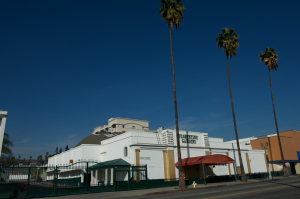Have You Ever Wondered… What On Earth Florentine Gardens Is?
Tag: Historic Hollywood
In the long stretch of flat-roofed structures that mark the north side of Hollywood Blvd between Bronson and Gower, there stands an oddity—a warehouse-sized building decorated with bas-relief Ionic columns and a giant orange canopy on brass legs. On the building’s façade is the name “Florentine Gardens” spelled out in tall, green letters that light up at night. For years, I would drive by on my way to the 101, wondering what the place was and who went there. Little did I know that it’s actually one of Hollywood’s oldest, almost-continually-running nightclubs.
On December 28, 1938 businessman Frank Bruni opened a glamorous dinner theatre on Hollywood Blvd’s easternmost edge. Catering to Hollywood’s elite along with its working classes, the Florentine Gardens charged a $1.25 cover charge or $2.50 to dine and dance. The building was designed by architect Gordon Kaufmann whose other notable achievements were the Los Angeles Times building, Greystone Mansion in Beverly Hills, and Hoover Dam. The original structure, which cost $500,000 to build, was designed to resemble a Moorish palace and proclaimed itself as having the finest dance floor on the Pacific Coast.
The club met with moderate success until 1940 when Bruni brought in showman Nils Thor Granlund to shake things up. Known as N.T.G. or “Granny,” Granlund was universally recognized as a master entertainer having produced elaborate live reviews for Loews Theatres in New York, managed and developed programming for WHN radio, and operated successful shows on Broadway.
Granlund brought his signature style of live reviews featuring scantily-clad chorus girls, comedians, and singers to Hollywood. He packed more than 500 seats nightly at Florentine Gardens with a floorshow that combined entertainment, sex appeal and excitement. He booked such-well known acts as Paul Whitman and his orchestra, Henny Youngman, the Mills Brothers and Sophie Tucker to entertain the crowds alongside breathtaking trapeze acts like The Flying Herzogs. He gave many budding actresses their start in the chorus line including Yvonne DeCarlo, who went on to become Lily Munster on the 1960s TV series.
Florentine Gardens was so popular that in 1942, an unknown named Norma Jeane Baker celebrated her marriage to first husband, Jim Dougherty at a wedding reception there. She, of course, went on to become Marilyn Monroe.
The war years were especially good for Florentine Gardens as thousands of servicemen flocked to Hollywood and reveled in the club’s special brand of entertainment. A devout patriot, Granlund let all servicemen in to his shows for free, reserving a special section for them where they could be surrounded by leggy showgirls and pulled on-stage to participate. But by 1948, the war was over, the club was no longer able to fill all of its seats and eventually filed for bankruptcy.
Florentine Gardens then became the Cotton Club, featuring black entertainers, until it closed in 1954. It later served as a dental school, and then a salsa-rock club until Kenneth MacKenzie bought the building in 1979 for about $680,000 and re-opened it as Florentine Gardens the next year. In 2005, the city - along with the Community Redevelopment Agency - sought to buy the building as part of a plan to develop a new fire station, but the plan was opposed by preservationists and did not come to fruition.
Today, Florentine Gardens is an 18 and over nightclub which caters mostly to a Latino crowd. The club has three huge dance floors with a mix of music for lovers of hip hop, techno, dance, Latin and the 80s. It is still going strong as a place where people gather to dance the night away and enjoy an evening out in Hollywood.
 Florentine Gardens today. Photo by Gary Leonard.
Florentine Gardens today. Photo by Gary Leonard.
Florentine Gardens
5951 Hollywood Blvd.
(323) 464-0706
florentinegardenshollywood.com
Kim Sudhalter has worked with the Hollywood Entertainment District since its early years, helping to attract investment and revitalize the area. Originally from Europe and New York, she is an architecture and history buff who has a deep and abiding love for Hollywood and its past.
